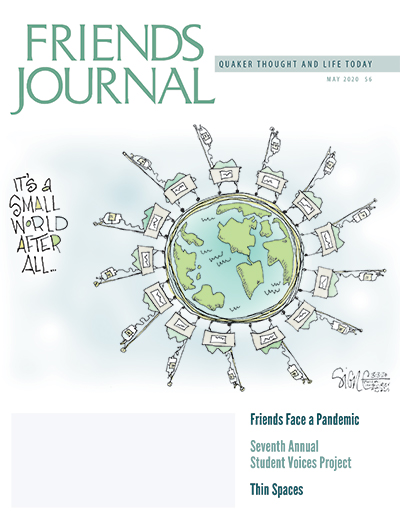
When my brother-in-law died two years ago, the customary obituary would have said he had passed away “after a long battle with leukemia.” But the military metaphor seemed particularly inappropriate for this gentle soul. He was a lifelong pacifist who had moved his family to Vietnam in 1964 to provide humanitarian service during the war and who devoted the rest of his life to mending, encouraging, and nurturing others through various forms of service around the world. So instead, our obituary said that he passed away “after a long journey” with leukemia.
I’m reminded of this as the COVID-19 pandemic continues to unfold, and so many in our country turn to words of warfare to describe their response: Fight. Battle. Defeat. Combat. Enemy. Doctors and nurses on the front lines. The governor of my own state, addressing an assembly of national guard soldiers activated in response to the pandemic, urged them to “kick coronavirus’s ass.” Perhaps such language arises easily in a highly militarized society that has waged “war” on everything from poverty to inflation to terror.
Let me be clear: as someone touched in childhood by the polio epidemic of the 1950s, I am forever grateful for the vaccines and the healthcare workers who saved countless people from that crippling disease. And I will rejoice when a way can be found to prevent anyone from ever again suffering and dying from COVID-19.
But might we as Quakers raise up a different language, a different narrative to describe that task? Let’s consider a few alternatives with more peaceful imagery.
The first comes from a time when I was working for American Friends Service Committee as a liaison with an environmental task force at Akwesasne, a Mohawk Nation community along the Saint Lawrence River. The people I met at Akwesasne saw their environmental projects as efforts to recover harmony with all creation. In the Mohawk view, transgressions disrupt that harmony and put the community out of balance. When that happens, what’s needed is a restoration of the balance, not retribution. Might this imagery of harmony and balance offer a friendlier vocabulary for addressing a pandemic?
Such imagery can already be found in medicine. For example, modern medical science teaches us that certain bacteria—“germs”—cause infection and disease. We’ve also learned that human gastrointestinal tracts host a vast array of bacteria—some of which are beneficial, even necessary, for our health. The wellbeing of these “gut microbiota” depends on a balance between the beneficial bacteria and the harmful ones. When something upsets this balance—as can happen when an antibiotic kills beneficial bacteria—the harmful bacteria can run amok and cause illness. Health returns when balance is restored.
Another example of this imagery of balance can be found in the polio epidemics of the last century. In the early 1900s, welcome advances in public sanitation and personal hygiene helped protect Americans from a host of dangerous diseases, from cholera and yellow fever to typhus and diphtheria. But as historian David M. Oshinsky has written in his Pulitzer Prize-winning book Polio: An American Story, this “antiseptic revolution brought risks as well as rewards.” Oshinsky notes that the poliovirus had been present in the environment for centuries, passing harmlessly from host to host without triggering an epidemic. For almost everyone, writes Oshinsky, polio had been “a mild infection followed by a lifetime of immunity.” But America’s new zeal for sanitizing lessened the likelihood that “people would come into contact with dangerous microbes early in life, when the infection was milder and maternal antibodies offered temporary protection.” As a result, polio ran amok. Not until the 1950s did science develop the vaccines to artificially replace the natural immunities that had formerly held polio in check. The ancient balance was restored.
So harmony and balance are already part of medicine’s imagery for addressing disease.
Now here’s another image, this one from the realm of social activism. In his 1935 book The Power of Non-Violence, Friend Richard B. Gregg suggested that nonviolent resistance can act as what he called “moral jiu-jitsu.” He was thinking of a martial arts expert whose defense against a violent attack is not to use violence against violence but to skillfully step out of the way and redirect the attacker’s energy elsewhere. Gregg believed that, used in this way, nonviolence could be an effective substitute for war.
In the coronavirus pandemic, hasn’t “social distancing” been an example of this very technique? We, in effect, step aside, step out of the way of the approaching pandemic, thus redirecting its strength and dissipating its power. And think of the ways we’ve been told are most effective at stopping a pandemic: Wash your hands. Don’t touch your face. Sneeze into your elbow. Protect your community by staying home. Look out for each other. Be kind, and be cooperative.
Are these a call to arms, a war cry? No, these are gentle and peaceful means. This language is about restoring balance and redirecting harmful forces, not about rousing to battle. It seems to me that the use of military metaphors during a pandemic is misplaced. We have better imagery at hand.
In times like these, we are being called upon to help create a new world out of the one we’ve lost. Alongside whatever else we do, perhaps Quakers can bring the small offering of a more peaceful—and accurate—way of describing the task before us.




Hooray for Phil Harnden. and his insightful reminders of the power of nonviolent responses to fearful threats
Hello
A very interesting article on the use of language used to describe the current pandemic; and I especially appreciate the metaphor of moral jiu‐jitsu.
Just an update on the mis-characterization of the polio epidemic as being a result of nature out of balance. Using data collected before Salk’s polio vaccine trial in a Michigan study, the study disproved increased hygiene of industrialized nations caused the children to have reduced resistance to the pathogen. The true cause of the epidemic was due to the huge increase in population (which resulted in the baby boomers) that increased the numbers of exposures to the pathogen.
I agree with your idea of removing the words warmongering from the lexicon used to describe the pandemic. We must speak of the search for balance, as you rightly do, a balance that should be used in every human relationship.